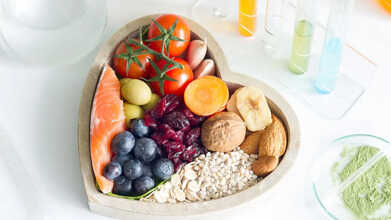- Health Conditions A-Z
- Health & Wellness
- Nutrition
- Fitness
- Health News
- Ayurveda
- Videos
- Medicine A-Z
- Parenting
- Web Stories
Don't Worry! We Found The Reason Why You Crave Sugar When You're Sick

Image Credits: Canva
You’re snuggled up on the couch, tissues in hand, battling the sniffles and body aches. As your body fights off illness, a peculiar urge creeps in—an intense craving for sugar and carb-laden comfort foods like chocolate, pastries, and bread. But why does this happen, especially when sickness often suppresses appetite? The answer lies in the complex interplay between our immune system, brain chemistry, and metabolic needs.
Understanding why your body craves sugar when you’re sick is the first step in making healthier choices. While the desire for sugary comfort foods is driven by biological and psychological mechanisms, indulging too much can be counterproductive to recovery. Instead of reaching for refined sugars, opt for nutrient-rich foods that provide long-lasting energy and support immune function.
The next time you are sick and crave a sweet something, try one of these instead: honey in tea, fresh fruit, or complex carbohydrates like whole grains. These can provide your body with the comfort and energy it seeks—without the unwanted side effects of refined sugar.
What Causes You to Crave Sugar When You Are Sick
Food craving is not just about taste; it is a combination of emotion, behavior, physiological reaction, and even evolutionary mechanisms. When you are ill, your body requires more energy to fuel the immune system and to enhance hunger signals. But sugar and carbohydrate craving is more than anything else because of the following reasons:
1. Immune System's Energy Requirement
When you become ill, your immune system works overtime, releasing an attack on intruding bacteria and viruses. All this extra work requires more energy, which the body attempts to replenish with quick and easy-to-digest sources—carbohydrates and sugar.
The stress of disease also triggers the release of cortisol, a hormone that helps mobilize stored energy stores by breaking down stored glucose. This creates a physiological state in which the body craves energy-rich foods to support immune function. Foods like high-sugar foodstuffs produce a rapid release of glucose and therefore temporary relief of the energy demands of the immune response.
2. Hunger Hormone Ghrelin and Its Function
Ghrelin, often referred to as the "hunger hormone," is secreted by the stomach to stimulate hunger in the brain. When the body recovers from illness and fights disease, metabolic activity increases as it restores tissues and fights disease, causing increased ghrelin secretion. That increase in ghrelin stimulates hunger for high-calorie foods, such as those containing carbohydrates and sugar, that provide an immediate boost of energy.
3. Reward System of the Brain and Sugar's Role in Comfort
The brain's reward system is one of the primary reasons we reach for sugar foods when we are sick. Glucose, the brain's primary source of fuel, is quickly absorbed from sugary and carbohydrate foods. This quick use stimulates the release of dopamine and serotonin, neurotransmitters associated with pleasure and mood.
Dopamine provides a temporary sense of comfort, which can be especially appealing when you’re feeling unwell. Serotonin, often referred to as the "feel-good hormone," is linked to carbohydrate consumption. In fact, studies have shown that carb-rich diets can increase serotonin levels, temporarily improving mood and reducing feelings of discomfort.
4. Downside of Sugar Cravings
While indulging in sweet treats might seem harmless when you are sick, excessive sugar use has negative effects on health and healing. Here's why:
Increased Inflammation: Excess sugar use can create systemic inflammation, which will worsen the symptoms of colds, flu, or other infections.
Immunocompromised Function: Research suggests that excessive sugar intake can impair the function of white blood cells and thus attenuate their ability to fight infections.
Energy Crashes: The typical "sugar rush" tends to be followed by an energy crash, leaving you worse off than you were originally.
Disturbed Gut Health: Since up to 90% of serotonin is released in the gut, excessive sugar consumption has the potential to disturb gut microbiota, immune function, and overall health.
5. Short-Lived High of a Sugar Rush
One of the most prevalent myths is that sugar is a source of long-lasting energy. While it has a tendency to make the body's blood sugar level spike, a short and ultimately ensuing crash later on causes it to induce even more fatigue and decreased alertness.
Research indicates that while carbohydrates may briefly elevate mood, they may also contribute to low energy levels after an hour of consumption. This is particularly problematic in the case of an already compromised body through illness.
In addition, frequent use of sugar has the ability to undermine impulse control with time, and so it becomes harder to resist desires and leads to an addiction pattern. For long-term users of sugar, this can create a withdrawal-like response, and therefore it is even harder to resist sugar consumption when one is ill.
What Your Brain Really Wants
In addition to mere cravings, your brain craves equilibrium in neurotransmitter function. Experiments in the 1970s and later have determined that higher carbohydrate consumption has been shown to raise tryptophan levels, the precursor to serotonin. This accounts for why candy can appear emotionally rewarding in illness.
Surprisingly, scientists have also learned that cravings for sugar are shaped to a significant degree by gut microbiota. Bacteria within the gastrointestinal system could even cause sugar cravings, particularly following antibiotics use, which would create a disturbance of gut flora.
How Can You Avoid Sugar When You Are Sick?
As much as one would love to treat themselves with sweets during sickness, excess sugar may not be the best choice in terms of recovery. Research shows that sugar interferes with vitamin absorption, reducing the body's ability to absorb vital nutrients required for immune function. It further contributes to inflammatory responses, exacerbating symptoms by exciting abnormal immune activity. It also decreases white blood cell efficiency, potentially weakening the body's inherent immune defense.
That does not imply that you must cut out sugar altogether. Natural sugars in whole foods like fruit carry essential vitamins and minerals for immune system function and satisfying cravings in a healthier way.
So, while your sweet tooth is tempting you, remember that smarter food choices can result in quicker recovery and improved sensations in the long run.
World Heart Day 2025: Nutritionist Reveals Heart-Healthy Foods You Must Eat And Avoid

Credits: Canva
When it comes to your heart, diet plays a crucial role. What you eat directly affects your heart health, helping it function better and reducing the risk of disease. Heart-healthy eating focuses on including nutrient-rich foods while cutting back on items that can harm your heart, such as foods high in saturated fat, added sugar, or salt. For World Heart Day, we spoke with a dietician to understand which foods support a healthy heart and which ones are best limited.
Best Food To Eat For A Healthy Heart
A heart-friendly diet revolves around fresh, wholesome foods. We got in touch with Anshul Singh, Team Leader, Clinical Nutritionist,Artemis Hospitals who told us some of the most beneficial options include:
- Vegetables: Leafy greens like spinach, kale, collard greens, and cabbage, as well as broccoli and carrots.
- Fruits: Apples, bananas, oranges, pears, grapes, and prunes.
- Whole grains: Brown rice, whole-grain bread or tortillas, and plain oatmeal.
- Low-fat dairy: Milk, cheese, and yogurt with little or no fat.
Protein-rich foods:
- Fish rich in omega-3s such as salmon, tuna, and trout.
- Lean meats like skinless chicken, turkey, or pork tenderloin.
- Eggs.
- Plant-based proteins like tofu, legumes (lentils, chickpeas, kidney beans), nuts, and seeds.
Healthy fats: Foods rich in monounsaturated and polyunsaturated fats are excellent for the heart. These include:
- Oils such as olive, canola, corn, safflower, sunflower, and soybean oil.
- Nuts and seeds like almonds, walnuts, pine nuts, pumpkin, sesame, and flax.
- Avocados, salmon, trout, and nut butters.
Foods To Avoid For A Healthy Heart
To protect your heart, it’s important to reduce intake of salt, saturated fats, added sugars, and alcohol. Here’s how to manage these in everyday life, as per Anshul Singh, Team Leader, Clinical Nutritionist,Artemis Hospitals:
Limit Sodium:
Adults and children over 14 should aim for less than 2,300 mg of sodium per day. Younger children may need even less. Those with high blood pressure may need stricter limits. Tips to reduce sodium include:- Check nutrition labels and choose products with lower sodium.
- Opt for fresh, frozen, or no-salt-added foods rather than pre-seasoned, marinated, or processed items.
- Cook at home when possible so you can control salt levels.
- Use herbs and spices instead of salt for flavor.
Cut Back on Saturated Fats:
“Bad” fats are mostly found in animal products like butter, cheese, and fatty cuts of meat. Saturated fats should account for less than 10% of daily calories. Instead:- Choose lean, skinless meats.
- Switch to lower-fat dairy options.
- Use vegetable oils like olive or canola instead of butter, lard, or coconut and palm oils.
Reduce Added Sugars:
Added sugars are those that are added to foods during processing or preparation, not naturally occurring in items like fruits. Limiting these helps you eat more nutrient-rich foods and stay within your daily calorie goals. Common forms of added sugar include brown sugar, high-fructose corn syrup, sucrose, dextrose, and raw sugar.By focusing on nutrient-dense foods, balancing your intake of fats, and being mindful of salt and sugar, you can give your heart the care it needs. Small adjustments in your diet can go a long way in keeping your heart healthy, strong, and resilient.
This Everyday Kitchen Staple May Help Your Lungs Battle Pollution

Credits: Canva
Air pollution is one of the leading environmental threats to health, affecting millions of people worldwide. Tiny airborne particles, known as PM2.5, are released by vehicles, factories, and other sources, and can penetrate deep into the lungs, causing inflammation and oxidative stress. Recent research from the University of Leicester highlights a simple yet effective way to support lung health amid these environmental pressures: eating more fruit.
The study, which analyzed data from over 200,000 participants in the UK Biobank, found that women who consumed four or more portions of fruit daily had smaller reductions in lung function when exposed to PM2.5, compared with those who ate less fruit. The effect was attributed to the natural antioxidants and anti-inflammatory compounds in fruits, which can help counteract the harmful impact of air pollution.
How Fruit Helps Your Lungs
Fruits are rich in vitamins, minerals, and phytonutrients that support overall respiratory health. Vitamin C and K, along with compounds like flavonoids and polyphenols, help reduce inflammation in the airways and combat oxidative damage caused by pollution. While eating fruit cannot replace prescribed medications or other medical interventions, it acts as a supportive measure that enhances lung resilience.Sarah Sleet, chief executive of the charity Asthma + Lung UK, explained that a high-fruit diet can maintain lung function and may help protect against environmental pollutants. She also emphasized that unequal access to healthy foods remains a barrier, with economically disadvantaged communities and certain ethnic groups often experiencing higher exposure to pollution.
Fruits Available in Your Kitchen To Help Your LungsYou don’t need exotic or expensive superfoods, common fruits in your kitchen can provide lung-protective benefits. Some of the most effective include:
- Apples: High in fiber and vitamin C, apples can improve overall respiratory health.
- Oranges and Citrus Fruits: These fruits are loaded with antioxidants that fight inflammation in the lungs.
- Berries (Strawberries, Blueberries, Raspberries): Packed with flavonoids and polyphenols, berries help neutralize oxidative stress caused by pollutants.
- Bananas: Containing potassium and vitamin B6, bananas help maintain energy and lung function.
- Grapes: Rich in resveratrol and other antioxidants, grapes may offer protection against lung damage.
Who Benefits Most
The Leicester study found the protective effect was especially noticeable among women, likely due to higher average fruit consumption compared with men. The research suggests that everyone, regardless of age or gender, can benefit from increasing daily fruit intake.Professor Sara De Matteis, chairwoman of the European Respiratory Society’s expert group on occupational and environmental health, noted that promoting fruit and plant-rich diets from an early age can contribute to better long-term lung health.
Adding fruit to your daily meals is an easy, accessible, and delicious way to support lung health. While it cannot fully eliminate the risks associated with air pollution, a diet rich in apples, berries, citrus fruits, bananas, and grapes can reduce the impact of pollutants and help maintain lung function. For the best results, pair a high-fruit diet with other healthy lifestyle habits, such as regular exercise, adequate hydration, and minimizing exposure to polluted environments.
Chicken Breast Vs Chicken Liver: Which Is More Nutritious?

Credits: Canva
Dr. Dominik Nischwitz, a dentist based in Germany, highlights on his Instagram that organ meats like liver are a nutrient-dense food, calling them "nature's multivitamin via real food," and suggests that eating organs was historically "prized & classed as a real luxury". His perspective aligns with how predators in the wild often prioritize organs like the brain, heart, and bone marrow over muscle meat.
A key reason for this prioritization is the immense concentration of nutrients in organs, which are essential for running "EVERY biochemical process in the human body especially your metabolism".
He has also posted on his Instagram @drdome1, comparing chicken liver with chicken breast. The post noted that chicken breast has 165cals per 100grams, while liver has 167cals per 100grams. However, the chicken breast has 0% vitamin A, 0% vitamin C, 1% folate, and 6% vitamin B12. Whereas, he noted that chicken liver has 267% vitamin A, 47% vitamin C, 144% folate, and 281% vitamin B12.
Chicken Liver's Vitamin Powerhouse
Chicken liver is significantly richer in numerous vitamins compared to chicken breast, offering a high percentage of the daily value (DV) for several B vitamins and Vitamin A.
Vitamin B12: Chicken liver has a massive amount of Vitamin B12, providing 675% more of the daily needs compared to chicken breast. Per 100 grams, chicken liver contains 16.58 μg of Vitamin B12, while chicken breast only has 0.37 μg.
Vitamin A: Chicken liver is an exceptional source of Vitamin A, containing 482 times more than chicken breast. Per 100 grams, chicken liver has 11,078 IU of Vitamin A, compared to 23 IU in chicken breast. This high content is necessary for various processes in the body, including those that regulate metabolism.
Other B Vitamins and Folate: The liver is loaded with all B vitamins. Specifically, per 100 grams, chicken liver has more Vitamin B2 (1.778 mg vs. 0.125 mg), Vitamin B5 (6.233 mg vs. 1.04 mg), and Folate (588 μg vs. 4 μg). These are crucial, for example, with B2 helping make FAD for fatty acid utilization, and B3 needed to make NAD+.
While chicken liver excels in these vitamins, the one exception is Vitamin B3, which chicken breast is richer in.
Essential Mineral Content
In addition to vitamins, chicken liver is a standout source of key minerals.
Iron: Chicken liver contains 8.99 mg of Iron per 100 grams, which is significantly more than chicken breast's 1.14 mg. This represents a 688.6% increase in Iron content for the liver.
Copper and Selenium: The liver is an excellent source of Copper. Chicken liver has 0.492 mg of Copper, substantially more than the 0.054 mg in chicken breast. It also contains more Selenium (54.6 μg vs. 26.2 μg). The presence of copper is important for how the body handles oxygen.
Zinc and Manganese: Compared to chicken breast, chicken liver is richer in Zinc and Manganese, showing a 147.2% and 1114.3% increase, respectively, in these minerals.
Fats and Cholesterol: Although chicken liver has more beneficial nutrients, it also contains more Cholesterol (345 mg per 100g) than chicken breast (91 mg per 100g).
Protein, Calorie, and Misconception Facts
While chicken breast is generally a better source of protein (33.44 g vs. 16.92 g per 100g), chicken liver is still considered a "VERY good source of protein" and is "VERY cost effective". Calorie content is very similar, with raw chicken liver at 119 kcal per 100g and cooked chicken breast at 187 kcal per 100g.
The notion that liver stores toxins is a "bogus claim." In a healthy animal, the liver's function is to transport and remove toxins from circulation, moving them to "less important and energetic tissue such as adipocytes (fat cells)". Historically, humans consumed the whole bird or animal, including the carcass for bone broth, indicating a shift in modern eating habits toward only muscle meat like chicken breast.
© 2024 Bennett, Coleman & Company Limited

